Thematic Dungeon Exploration (de'Arnise Hold)
I’ve been guiding parties through the dungeons of Baldur’s Gate II for over two decades. In many ways, it’s become routine—I know the paths, the puzzles, the key encounters. But now and then, when you slow down and really look around, the level design reveals some fascinating oddities: deliberate choices that hint at a deeper story, sometimes left unspoken.
Let’s begin with de’Arnise Keep.
The First Floor: A Gatehouse With a Bell
Right after entering the dungeon, you find yourself in a dark room, filled with ambiguous things. Details are hard to make out, and pressing Tab↹ reveals nothing for your hero to pocket. But hold on a moment. Look closer.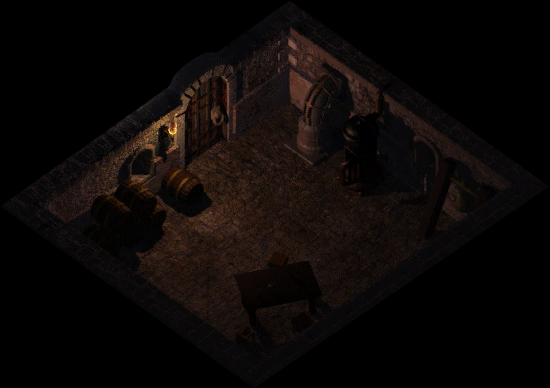
(messing with the image a bit to enhance visibility)
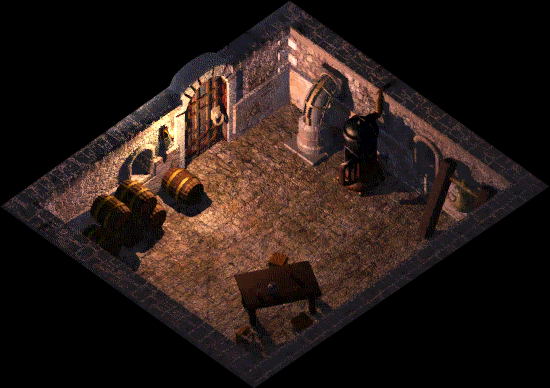
Closest to the light, and thus most easily spotted, is a strange pipe, emerging from the ground and disappearing into the wall. It’s richly decorated—clearly not just plumbing. Whatever machinery it once connected to, it was important. It hints at some mysterious infrastructure buried beneath the castle. Sadly, nothing else in the keep seems tied to it—but symbolically, its message is clear: the foundations of de’Arnise Hold are more complex than they appear.
Other details are easier to parse: a table with stools, an oven, a large bell. This wasn’t just an overlooked corner of the keep—it was recognized as a vulnerability. Guards were posted here. The bell was presumably meant to sound an alarm.
But think about what that means. This passage wasn’t forgotten—it was known. And instead of being sealed or fortified, it was staffed by a handful of soldiers with the instruction to ring for help if an invading force emerged from the dark.
But even if they had the presence of mind to act and accomplished that task, the bell would signal their comrades to seal the doors behind them, cutting off the breach… and abandoning them.
That’s not a defense plan. That’s a fantasy—one that hopes the problem won’t come, and if it does, that someone else will be left to deal with it.
It suggests a defensive mindset that was halfway between panic and denial. Rather than reinforcing the keep’s weakest point, the designers simply staffed it and prayed it wouldn’t be found. The ancestor who built de’Arnise Hold’s towering walls would not have stood for this. Whoever designed this room wasn’t planning for success. They were hoping no one would notice.
A Hidden Forge, A Secret Weapon
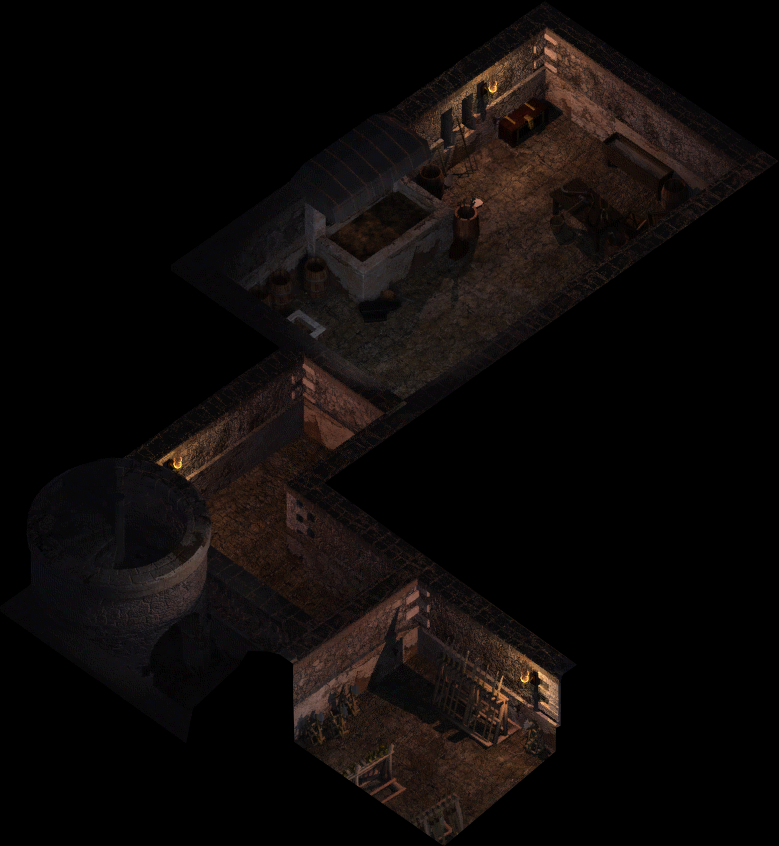
On the same floor, you’ll find a smithing workshop hidden behind not one but two secret doors. That’s strange. Smithies are anything but discreet—between the clanging metal, roaring furnaces, and coal deliveries, they are typically loud, open and essential parts of a keep’s infrastructure.
But this isn’t a smithy.
When you examine the forge, you’re told it’s magical—operated by will of mind alone—and specifically designed to reforge the Flail of the Ages, whose pieces are scattered throughout the keep. In other words, this is a magical artifact built solely to reassemble a weapon the castle’s former lord deliberately dismantled. And we later learn why: the completed flail attracts ambushes from rakshasa.
The secrecy makes more sense then. The forge isn’t hidden because it’s a forge—it’s hidden to ensure that no one could easily reconstruct the flail without his knowledge—a safeguard to keep his ace in the hole from falling into the wrong hands.
The Trophy Room: Memory in the Dark
One last item of note exists on the first floor: The trophy room hidden behind the hidden forge. It’s a strange place for such a room—dark, out of sight, and difficult to access. Not exactly how one displays their triumphs. The space is a paradox.
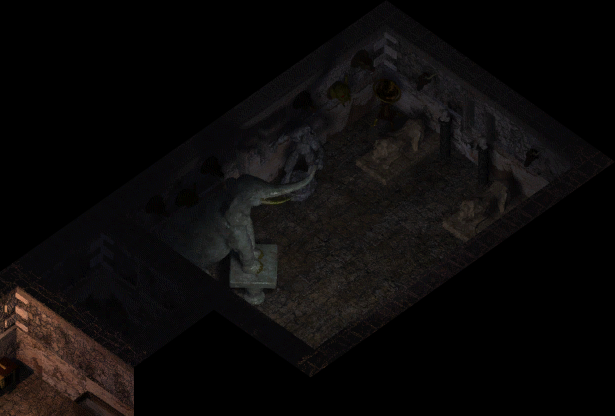
(messing with the image a bit to enhance visibility)

Were the taxidermy mounts here exiled from the main halls by a later lord who found them tasteless or grotesque? There’s a globus in the corner too—ornate, valuable. Did it no longer suit the decor? But this feels like more than just a junk room for outdated furnishings.
One object in particular defies that explanation: the life-sized marble elephant. It’s far too large to have passed through the keep’s doors. It could not have been smuggled in post-construction, and teleportation magic strong enough to reposition such a heavy object would be a rare and extravagant resource—even for a noble house.
That suggests this room wasn’t always hidden. Once, it would have been proudly accessible, well-lit and meant to impress guests with its display of reach and accomplishment. It likely connected directly to the main hall through the wall that now seals it off.
So why was that wall closed? Why did the keep bury this room—and its memory?
The Second Floor: Social Secrets
Things get stranger upstairs.

There’s a secret pathway—but it can be accessed through a very visible door (though that door is locked before the castle is saved). This might seem like sloppy design at first, but it’s actually a clever misdirection. The door makes the corner seem mundane, discouraging players from searching for another hidden entrance just beside it.
Walk through the hidden entrance, and you’ll find yourself in a well-furnished chamber with seating for eight—a place built for private gatherings, likely including servants and guests. So why hide it?
I think it was never meant to be truly secret. More likely, it served as a kind of exclusive retreat—a nobles’ version of a treehouse. A place for members of the household or their peers to play at secrecy, perhaps indulge in gossip, plotting, or youthful rebellion. The presence of a bathing area suggests more than just politics might have unfolded here.
After the keep is taken over by a fighter protagonist, the area gains a darker tone. Chanelle the maid is hiding here—until she is brought before the new lord to be married off at their discretion. Fortunately, her dialogue doesn’t suggest coercion, but the setting adds an uncomfortable undertone.
The Chapel Upstairs: A Question of Access
There’s another oddity on the second floor: a chapel tucked away behind a hidden door in the master bedroom.
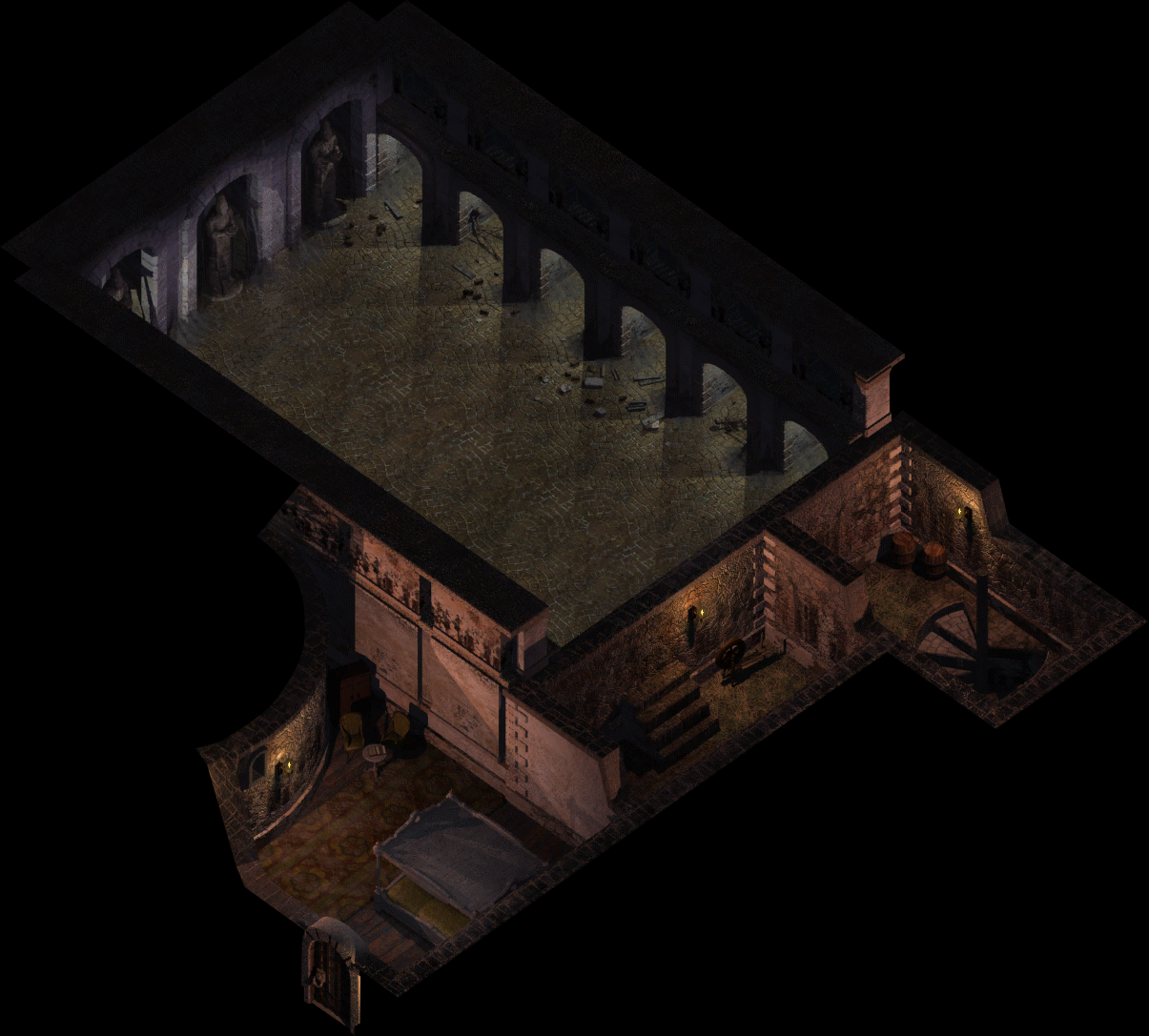
Why would a supposedly public chapel be so inaccessible?
Stranger still, a wandering priest of Tempus later shows up here—already well informed about this sealed space. My theory? He’s not just a wanderer—he’s a spy hired by the keep’s subjects to keep tabs on what happens behind the wall. With Gorion’s Ward rarely home, he probably also claimed the bedroom for himself.
Even more suspicious: the “secret” chapel entrance sits at the top of a small staircase. It’s camouflaged, yes, but the steps betray its existence to any attentive observer. This wasn’t originally hidden. Someone deliberately sealed it off.
The Cellar: Torture and Tyr
Moving down into the cellar, things take a much darker turn.
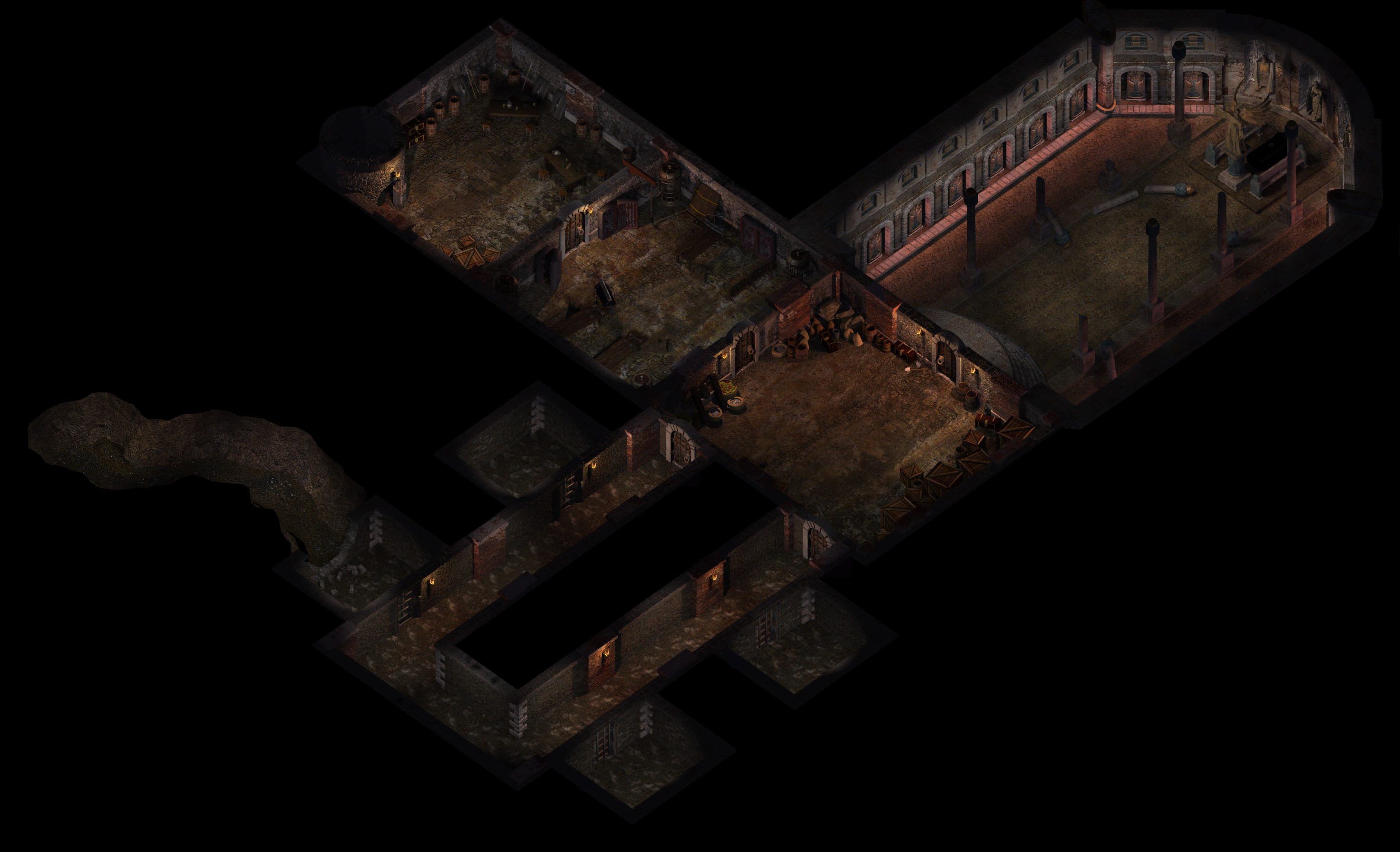
This level includes a full torture chamber with enough space for multiple victims at once, as well as a prison complex with four cells. At least five stools are positioned at the entrance—likely for guards. Next to the prison cells we see what appears to be fresh fruit.
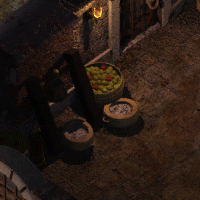 This implies that the operation was not some forgotten relic, but an active facility—one that, inexplicably, would have to be provisioned through the hidden passage in the master bedroom.
This implies that the operation was not some forgotten relic, but an active facility—one that, inexplicably, would have to be provisioned through the hidden passage in the master bedroom.
But the strangest part lies beyond the torture area: a chapel dedicated to Tyr.
Now, Tyr is not generally thought to condone torture. But it isn’t unthinkable that an arrogant noble might convince himself he’s enacting divine justice by tormenting those he sees as sinners or criminals. Still, it’s difficult to overlook the symbolic weight of this layout. The only path to Tyr’s altar leads through a place of suffering and restraint. It would take a twisted mind—or at least a thoroughly compromised one—to place a god of justice at the far end of a torture hall.
And maybe that’s the point. Maybe this is what the original level designers of Baldur’s Gate II wanted us to see about the de’Arnise family. Not only did they never learn how to contract their name properly—they also saw nothing wrong with building a house of justice atop a foundation of cruelty.
Hidden Walls, Hidden Legacy
Interestingly, both chapels—the upstairs one and the one in the cellar—are accessed from the same bedroom. And neither seem to have been originally designed as hidden.
The wall between the master bedroom and the hidden room behind it is inconsistent with the rest of the wall. (see above) I propose that this master bedroom was a later conversion of the space, constructed deliberately to discourage investigations of the wall. That would explain how so much foot traffic could once pass through this space, before the renovation.
Nalia tells us the cellar was “walled up,” but clearly it was not truly sealed. The trolls entered the keep through this route during their invasion, and the secret doors remain functional. That means that the trolls did not break down any barriers—they simply opened and closed the hidden doors as needed. Which in turn suggests those doors were designed for continued use.
This points to a weak, half-hearted attempt at burying the castle’s past. The late Lord de’Arnise didn’t purge its corruption—he just plastered over it and hoped no one would dig too deep. This echoes how he handled Nalia’s unwanted engagement: indecisive, avoidant, ultimately complicit.
So why hide the upstairs chapel so thoroughly as well?
My theory is simple: when the master bedroom was relocated, the chapel’s placement became awkward. Rather than break through a new entrance, the lord converted it into a private treasury and concealed it—along with the keep’s darker history.
De’Arnise Hold is more than just an early-game stronghold. It's a microcosm of forgotten sins, quiet repression, and generational failure. The design is clever—not just mechanically, but narratively. If you stop and explore its layout, it starts to whisper its buried story.
Let’s begin with de’Arnise Keep.
The First Floor: A Gatehouse With a Bell
Right after entering the dungeon, you find yourself in a dark room, filled with ambiguous things. Details are hard to make out, and pressing Tab↹ reveals nothing for your hero to pocket. But hold on a moment. Look closer.

(messing with the image a bit to enhance visibility)

Closest to the light, and thus most easily spotted, is a strange pipe, emerging from the ground and disappearing into the wall. It’s richly decorated—clearly not just plumbing. Whatever machinery it once connected to, it was important. It hints at some mysterious infrastructure buried beneath the castle. Sadly, nothing else in the keep seems tied to it—but symbolically, its message is clear: the foundations of de’Arnise Hold are more complex than they appear.
Other details are easier to parse: a table with stools, an oven, a large bell. This wasn’t just an overlooked corner of the keep—it was recognized as a vulnerability. Guards were posted here. The bell was presumably meant to sound an alarm.
But think about what that means. This passage wasn’t forgotten—it was known. And instead of being sealed or fortified, it was staffed by a handful of soldiers with the instruction to ring for help if an invading force emerged from the dark.
But even if they had the presence of mind to act and accomplished that task, the bell would signal their comrades to seal the doors behind them, cutting off the breach… and abandoning them.
That’s not a defense plan. That’s a fantasy—one that hopes the problem won’t come, and if it does, that someone else will be left to deal with it.
It suggests a defensive mindset that was halfway between panic and denial. Rather than reinforcing the keep’s weakest point, the designers simply staffed it and prayed it wouldn’t be found. The ancestor who built de’Arnise Hold’s towering walls would not have stood for this. Whoever designed this room wasn’t planning for success. They were hoping no one would notice.
A Hidden Forge, A Secret Weapon

On the same floor, you’ll find a smithing workshop hidden behind not one but two secret doors. That’s strange. Smithies are anything but discreet—between the clanging metal, roaring furnaces, and coal deliveries, they are typically loud, open and essential parts of a keep’s infrastructure.
But this isn’t a smithy.
When you examine the forge, you’re told it’s magical—operated by will of mind alone—and specifically designed to reforge the Flail of the Ages, whose pieces are scattered throughout the keep. In other words, this is a magical artifact built solely to reassemble a weapon the castle’s former lord deliberately dismantled. And we later learn why: the completed flail attracts ambushes from rakshasa.
The secrecy makes more sense then. The forge isn’t hidden because it’s a forge—it’s hidden to ensure that no one could easily reconstruct the flail without his knowledge—a safeguard to keep his ace in the hole from falling into the wrong hands.
The Trophy Room: Memory in the Dark
One last item of note exists on the first floor: The trophy room hidden behind the hidden forge. It’s a strange place for such a room—dark, out of sight, and difficult to access. Not exactly how one displays their triumphs. The space is a paradox.

(messing with the image a bit to enhance visibility)

Were the taxidermy mounts here exiled from the main halls by a later lord who found them tasteless or grotesque? There’s a globus in the corner too—ornate, valuable. Did it no longer suit the decor? But this feels like more than just a junk room for outdated furnishings.
One object in particular defies that explanation: the life-sized marble elephant. It’s far too large to have passed through the keep’s doors. It could not have been smuggled in post-construction, and teleportation magic strong enough to reposition such a heavy object would be a rare and extravagant resource—even for a noble house.
That suggests this room wasn’t always hidden. Once, it would have been proudly accessible, well-lit and meant to impress guests with its display of reach and accomplishment. It likely connected directly to the main hall through the wall that now seals it off.
So why was that wall closed? Why did the keep bury this room—and its memory?
The Second Floor: Social Secrets
Things get stranger upstairs.

There’s a secret pathway—but it can be accessed through a very visible door (though that door is locked before the castle is saved). This might seem like sloppy design at first, but it’s actually a clever misdirection. The door makes the corner seem mundane, discouraging players from searching for another hidden entrance just beside it.
Walk through the hidden entrance, and you’ll find yourself in a well-furnished chamber with seating for eight—a place built for private gatherings, likely including servants and guests. So why hide it?
I think it was never meant to be truly secret. More likely, it served as a kind of exclusive retreat—a nobles’ version of a treehouse. A place for members of the household or their peers to play at secrecy, perhaps indulge in gossip, plotting, or youthful rebellion. The presence of a bathing area suggests more than just politics might have unfolded here.
After the keep is taken over by a fighter protagonist, the area gains a darker tone. Chanelle the maid is hiding here—until she is brought before the new lord to be married off at their discretion. Fortunately, her dialogue doesn’t suggest coercion, but the setting adds an uncomfortable undertone.
The Chapel Upstairs: A Question of Access
There’s another oddity on the second floor: a chapel tucked away behind a hidden door in the master bedroom.

Why would a supposedly public chapel be so inaccessible?
Stranger still, a wandering priest of Tempus later shows up here—already well informed about this sealed space. My theory? He’s not just a wanderer—he’s a spy hired by the keep’s subjects to keep tabs on what happens behind the wall. With Gorion’s Ward rarely home, he probably also claimed the bedroom for himself.
Even more suspicious: the “secret” chapel entrance sits at the top of a small staircase. It’s camouflaged, yes, but the steps betray its existence to any attentive observer. This wasn’t originally hidden. Someone deliberately sealed it off.
The Cellar: Torture and Tyr
Moving down into the cellar, things take a much darker turn.

This level includes a full torture chamber with enough space for multiple victims at once, as well as a prison complex with four cells. At least five stools are positioned at the entrance—likely for guards. Next to the prison cells we see what appears to be fresh fruit.
 This implies that the operation was not some forgotten relic, but an active facility—one that, inexplicably, would have to be provisioned through the hidden passage in the master bedroom.
This implies that the operation was not some forgotten relic, but an active facility—one that, inexplicably, would have to be provisioned through the hidden passage in the master bedroom.But the strangest part lies beyond the torture area: a chapel dedicated to Tyr.
Now, Tyr is not generally thought to condone torture. But it isn’t unthinkable that an arrogant noble might convince himself he’s enacting divine justice by tormenting those he sees as sinners or criminals. Still, it’s difficult to overlook the symbolic weight of this layout. The only path to Tyr’s altar leads through a place of suffering and restraint. It would take a twisted mind—or at least a thoroughly compromised one—to place a god of justice at the far end of a torture hall.
And maybe that’s the point. Maybe this is what the original level designers of Baldur’s Gate II wanted us to see about the de’Arnise family. Not only did they never learn how to contract their name properly—they also saw nothing wrong with building a house of justice atop a foundation of cruelty.
Hidden Walls, Hidden Legacy
Interestingly, both chapels—the upstairs one and the one in the cellar—are accessed from the same bedroom. And neither seem to have been originally designed as hidden.
The wall between the master bedroom and the hidden room behind it is inconsistent with the rest of the wall. (see above) I propose that this master bedroom was a later conversion of the space, constructed deliberately to discourage investigations of the wall. That would explain how so much foot traffic could once pass through this space, before the renovation.
Nalia tells us the cellar was “walled up,” but clearly it was not truly sealed. The trolls entered the keep through this route during their invasion, and the secret doors remain functional. That means that the trolls did not break down any barriers—they simply opened and closed the hidden doors as needed. Which in turn suggests those doors were designed for continued use.
This points to a weak, half-hearted attempt at burying the castle’s past. The late Lord de’Arnise didn’t purge its corruption—he just plastered over it and hoped no one would dig too deep. This echoes how he handled Nalia’s unwanted engagement: indecisive, avoidant, ultimately complicit.
So why hide the upstairs chapel so thoroughly as well?
My theory is simple: when the master bedroom was relocated, the chapel’s placement became awkward. Rather than break through a new entrance, the lord converted it into a private treasury and concealed it—along with the keep’s darker history.
De’Arnise Hold is more than just an early-game stronghold. It's a microcosm of forgotten sins, quiet repression, and generational failure. The design is clever—not just mechanically, but narratively. If you stop and explore its layout, it starts to whisper its buried story.
0

Comments
Of course this sort of random/non-sensical layout was very common in the early days of this sort of gaming. I bet many of us started with buddies doing random dungeon design populated off of random encounter charts. Early computer dungeon crawls were no different, Telengard, Wizardy etc there was often no rhyme or reason to what was where. Some CRPGs like Phantasie did make more effort to have themed dungeons, which started to make story and internal reality a little more solid.
By the time we get to things like BG its easy to appreciate the efforts made at rational encounter tables and settings that are connected and rational... more or less.
In a place like D'Arnise Keep I figure some things are abstracted, like possibly areas blocked off by the defenders in an emergency by defenders or trolls (damage/vandalism or even temporary blockades and battlements). And I always assumed the hidden areas on the second floor (chapel and stairs to the basements) were merely those ways currently accessible. A more rational later map, for a repaired stronghold with easier access to public areas would have been nice. But it likely would have been hard to justify too much effort for something that would only apply to a small portion of gamers.
It is amusing to wonder some of what the original designers were thinking on these things. Although at this point, I figure the game mostly belongs to us players. When I do a run I like to make it my own story.
Keep 'em coming!
If it's just nitpicking, that should be avoided. The game doesn't deserve that.
But it's also quite a bit of work, of course. (I notably ran out of steam toward the end of the article on Firkraag's maze.)
I completely sympathize with burning out on such a project. My enthusiasm for specific hobbies, whether it’s scale modeling or Baldur’s Gate waxes and wanes irregularly.
I wish I had the time to compile some of the best reads in this forum into a fanzine of sorts (like Wild Surge used to be). What with the recent influx of spam I can't help but fear it might not be long for this world.